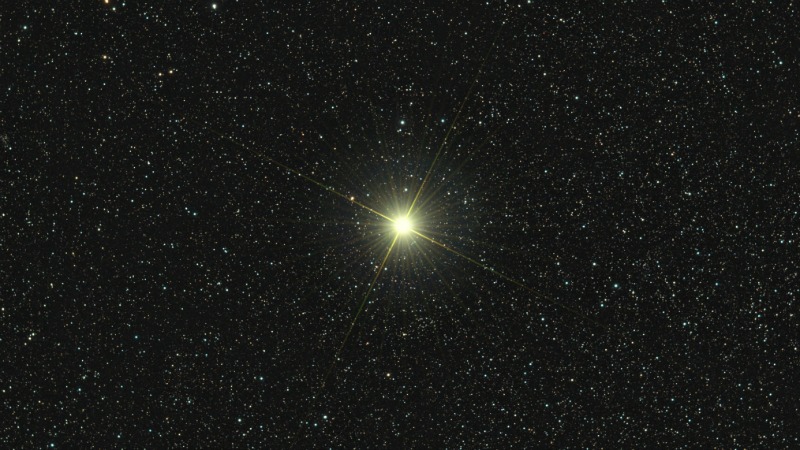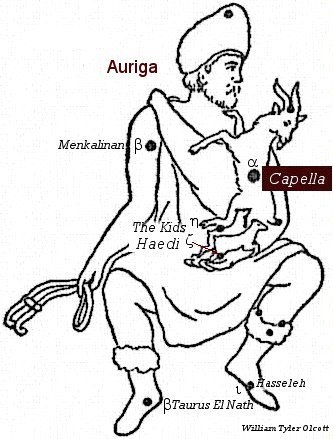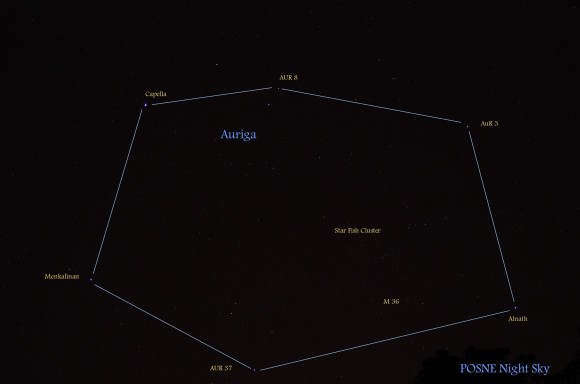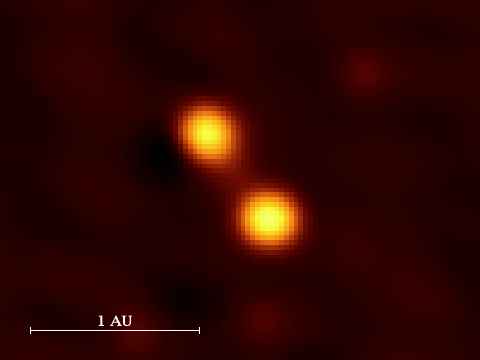
Image of star Capella via cameralabs.
Capella is the sixth brightest star in the night sky and the brightest point in the constellation Auriga the Charioteer. Capella, also known as Alpha Aurigae, is prominent in the Northern Hemisphere on winter evenings. Capella is also the northernmost star in the huge asterism known as the Winter Hexagon.
The 2021 lunar calendars are here! Going fast. Order yours before they’re gone!
Capella shares a spectral type with our sun, G, making it a yellow star. In fact, Capella is the biggest and brightest yellow star visible in our sky. It’s much bigger and brighter than our sun in absolute terms, and, of course, much farther away, about 42 light-years in contrast to our sun’s eight light-minutes.
Keep reading to learn more about this beautiful golden star, Capella, which, by the way, is the Latin word for nanny goat. Capella is sometimes called the Goat Star.

Capella, the Goat Star, is seen as a goat that the Charioteer carries on his shoulder. Notice the 2 baby goats at the larger goat’s feet. In the sky, 2 fainter stars – known as The Kids – denote them. Image via Constellationsofwords.com.
How to find Capella in the night sky. From mid-latitudes of the U.S. and Europe, Capella is far enough to the north to be seen at some time of the night all year round. For us in the Northern Hemisphere, it’s best in winter, when you’ll find golden Capella high overhead before bedtime. In the autumn, when Capella is lower near the northeastern horizon and appearing through a thick layer of Earth’s atmosphere, the star twinkles brightly, flashing colors of red, blue and green.
Capella is the brightest star in a five-sided pentagonal shape that makes up the constellation Auriga. The shape is difficult to reconcile with the idea of a man driving a chariot, but it’s a noticeable pattern and easy to find.
Here is the key to knowing you’ve found Capella. Near it, you’ll find a tiny asterism – a noticeable pattern on the sky’s dome – consisting of three fainter stars. This little triangle of stars is called The Kids, and it makes Capella instantly recognizable.

Look for Capella in the Northern Hemisphere winter.

Capella’s constellation Auriga, via EarthSky Facebook friend Dennis Chabot.
Science of Capella. Like so many stars that appear single to the eye, Capella actually consists of two stars. Capella A and Capella B, as they’re called, are similar to each other, both roughly 10 times the sun’s diameter. They emit about 80 and 50 times more overall light than the sun, respectively. Another component to this system, a binary of small red stars, orbits about a light-year away. Casual observers will not be able to separate these stars through backyard telescopes.
Capella A and B are both yellow giant stars at the end of their normal lifetimes. Each being more than 2 1/2 times more massive than the sun, the two components of Capella likely are also younger. This is because more massive stars have higher internal pressures, which causes them to burn their nuclear fuel faster and to have shorter lifespans. The stars of Capella are in a transitional period from the smaller, hotter stars they once were, to the cooler and larger red giants they must ultimately become in their final phase. However, for now, their surface temperatures are similar to that of the sun, and so they share its spectral type of G.
The two stars we see as Capella mark the sixth brightest star in our sky. (Seventh if you count the sun.) Astronomers measure the combined magnitude of this system as 0.08.

The Capella system consists of 2 stars. Image via Atlas of the Universe.
Capella in history and mythology. For such a large constellation with such a bright star, the mythology of Auriga and Capella is sparse. The constellation has been associated with the Greek sea god Poseidon (the Roman god Neptune). Other stories say Auriga represents Erichthonius, the ancient lame king of Athens who invented the horse-drawn chariot.
Auriga seems to have been associated with shepherds and flocks, so the title of nanny goat – or “she goat” – for Capella is reasonable. However, neither Capella nor its constellation Auriga figures prominently in any major mythological stories from Greek or Roman culture.
Richard Hinkley Allen, in his famed Star Names, says that the ancient Arabs called the star Capella by a name that meant “The Driver” and implies that this star was seen as a shepherd driving a flock across the sky. The flock might have been the nearby star cluster the Pleiades, although – instead of sheep or goats – early Arabian stargazers saw this pattern composed of camels. Capella was also apparently important in ancient Egypt. It appears on the Dendera Zodiac as a mummified cat.
In China, Capella and four other stars of Auriga were known as the Five Chariots. The other four stars are Auriga’s Beta, Theta, Kappa and Gamma (El Nath, which is now Beta Tauri).
Capella’s position is RA: 5h 16m 41.4s, Dec: +45° 59′ 53″.
Enjoying EarthSky? Sign up for our free daily newsletter today!
Bottom line: Capella is the brightest star in the constellation Auriga the Charioteer and the sixth brightest star in the night sky. Capella is prominent in the Northern Hemisphere’s winter sky and makes up one of the points in the Winter Hexagon.
from EarthSky https://ift.tt/3nIKasm

Image of star Capella via cameralabs.
Capella is the sixth brightest star in the night sky and the brightest point in the constellation Auriga the Charioteer. Capella, also known as Alpha Aurigae, is prominent in the Northern Hemisphere on winter evenings. Capella is also the northernmost star in the huge asterism known as the Winter Hexagon.
The 2021 lunar calendars are here! Going fast. Order yours before they’re gone!
Capella shares a spectral type with our sun, G, making it a yellow star. In fact, Capella is the biggest and brightest yellow star visible in our sky. It’s much bigger and brighter than our sun in absolute terms, and, of course, much farther away, about 42 light-years in contrast to our sun’s eight light-minutes.
Keep reading to learn more about this beautiful golden star, Capella, which, by the way, is the Latin word for nanny goat. Capella is sometimes called the Goat Star.

Capella, the Goat Star, is seen as a goat that the Charioteer carries on his shoulder. Notice the 2 baby goats at the larger goat’s feet. In the sky, 2 fainter stars – known as The Kids – denote them. Image via Constellationsofwords.com.
How to find Capella in the night sky. From mid-latitudes of the U.S. and Europe, Capella is far enough to the north to be seen at some time of the night all year round. For us in the Northern Hemisphere, it’s best in winter, when you’ll find golden Capella high overhead before bedtime. In the autumn, when Capella is lower near the northeastern horizon and appearing through a thick layer of Earth’s atmosphere, the star twinkles brightly, flashing colors of red, blue and green.
Capella is the brightest star in a five-sided pentagonal shape that makes up the constellation Auriga. The shape is difficult to reconcile with the idea of a man driving a chariot, but it’s a noticeable pattern and easy to find.
Here is the key to knowing you’ve found Capella. Near it, you’ll find a tiny asterism – a noticeable pattern on the sky’s dome – consisting of three fainter stars. This little triangle of stars is called The Kids, and it makes Capella instantly recognizable.

Look for Capella in the Northern Hemisphere winter.

Capella’s constellation Auriga, via EarthSky Facebook friend Dennis Chabot.
Science of Capella. Like so many stars that appear single to the eye, Capella actually consists of two stars. Capella A and Capella B, as they’re called, are similar to each other, both roughly 10 times the sun’s diameter. They emit about 80 and 50 times more overall light than the sun, respectively. Another component to this system, a binary of small red stars, orbits about a light-year away. Casual observers will not be able to separate these stars through backyard telescopes.
Capella A and B are both yellow giant stars at the end of their normal lifetimes. Each being more than 2 1/2 times more massive than the sun, the two components of Capella likely are also younger. This is because more massive stars have higher internal pressures, which causes them to burn their nuclear fuel faster and to have shorter lifespans. The stars of Capella are in a transitional period from the smaller, hotter stars they once were, to the cooler and larger red giants they must ultimately become in their final phase. However, for now, their surface temperatures are similar to that of the sun, and so they share its spectral type of G.
The two stars we see as Capella mark the sixth brightest star in our sky. (Seventh if you count the sun.) Astronomers measure the combined magnitude of this system as 0.08.

The Capella system consists of 2 stars. Image via Atlas of the Universe.
Capella in history and mythology. For such a large constellation with such a bright star, the mythology of Auriga and Capella is sparse. The constellation has been associated with the Greek sea god Poseidon (the Roman god Neptune). Other stories say Auriga represents Erichthonius, the ancient lame king of Athens who invented the horse-drawn chariot.
Auriga seems to have been associated with shepherds and flocks, so the title of nanny goat – or “she goat” – for Capella is reasonable. However, neither Capella nor its constellation Auriga figures prominently in any major mythological stories from Greek or Roman culture.
Richard Hinkley Allen, in his famed Star Names, says that the ancient Arabs called the star Capella by a name that meant “The Driver” and implies that this star was seen as a shepherd driving a flock across the sky. The flock might have been the nearby star cluster the Pleiades, although – instead of sheep or goats – early Arabian stargazers saw this pattern composed of camels. Capella was also apparently important in ancient Egypt. It appears on the Dendera Zodiac as a mummified cat.
In China, Capella and four other stars of Auriga were known as the Five Chariots. The other four stars are Auriga’s Beta, Theta, Kappa and Gamma (El Nath, which is now Beta Tauri).
Capella’s position is RA: 5h 16m 41.4s, Dec: +45° 59′ 53″.
Enjoying EarthSky? Sign up for our free daily newsletter today!
Bottom line: Capella is the brightest star in the constellation Auriga the Charioteer and the sixth brightest star in the night sky. Capella is prominent in the Northern Hemisphere’s winter sky and makes up one of the points in the Winter Hexagon.
from EarthSky https://ift.tt/3nIKasm

Aucun commentaire:
Enregistrer un commentaire